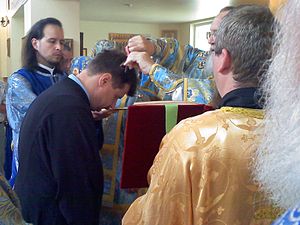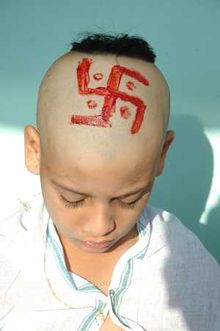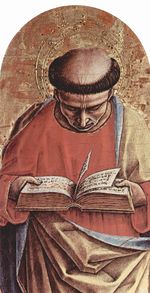- Tonsure
-
Tonsure is the traditional practice of Christian churches of cutting or shaving the hair from the scalp of clerics, monastics, and, in the Eastern Orthodox Church, all baptized members. Tonsure, usually qualified by the name of the religion concerned, is now sometimes used more generally for such cutting or shaving for monks, devotees, or mystics of other religions as a symbol of their renunciation of worldly fashion and esteem, e.g., by Buddhist novices and monks, and some Hindu streams.
Contents
Christianity
History and development
The origin of the tonsure remains unclear, but it certainly was not widely known in antiquity. There were three forms of tonsure known in the 7th and 8th centuries:
- The Oriental, which claimed the authority of Saint Paul the Apostle (Acts 18:18) and consisted of shaving the whole head. This was observed in the Eastern churches, including the Eastern Orthodox Church and the Eastern Catholic Churches. Hence Theodore of Tarsus, who had acquired his learning in Byzantine Asia Minor and bore this tonsure, had to allow his hair to grow for four months before he could be tonsured after the Roman fashion, and then ordained Archbishop of Canterbury by Pope Vitalian in 668.
- The Celtic, the exact shape of which is unclear from the sources, but in some way involved shaving the head from ear to ear.[1] The shape may have been semicircular, arcing forward from a line between the ears, but another popular suggestion, less borne out in the sources, proposes that the entire forehead was shaved back to the ears.[2] More recently a triangular shape, with one point at the front of the head going back to a line between the ears, has been suggested.[1] The Celtic tonsure was worn in Ireland and Great Britain and was connected to the distinct set of practices known as Celtic Christianity.[3] It was greatly despised by those affiliated with the Roman custom, who considered it unorthodox and associated it with the damned Simon Magus.[4] Some sources have also suggested links between this tonsure and that worn by druids in the Pre-Roman Iron Age [5] [6].
- The Roman: this consisted of shaving only the top of the head, so as to allow the hair to grow in the form of a crown. This is claimed to have originated with Saint Peter, and is the practice of the Latin Rite of the Catholic Church.
Ancient and medieval usage
Eastern Christianity
The following two sub-sections consist of quotes from Saint Germanus I, Patriarch of Constantinople (715-730):
Clerical Tonsure
The double crown inscribed on the head of the priest through tonsure represents the precious head of the chief-apostle Peter. When he was sent out in the teaching and preaching of the Lord, his head was shaved by those who did not believe his word, as if in mockery. The Teacher Christ blessed this head, changed dishonor into honor, ridicule into praise. He placed on it a crown made not out of precious stones, but one which shines more than gold, topaz, or precious stone – with the stone and rock of faith. Peter, the most-holy, the summit, beauty, and crown of the twelve stones, which are the apostles, is the hierarch of Christ.[7]
Monastic Tonsure
The total tonsuring of the head is in imitation of the holy Apostle James, brother of the Lord, and the Apostle Paul, and of the rest.[8]
Western Christianity
Clerical Tonsure
In the Latin or Western Rite of the Catholic Church, "first tonsure" was, in medieval times, and generally through 1972,[9] the rite of inducting someone into the clergy and qualifying him for the civil benefits once enjoyed by clerics. Tonsure was a prerequisite for receiving the minor and major orders. Failing to maintain tonsure was the equivalent of attempting to abandon one's clerical state, and in the 1917 Code of Canon Law, any cleric in minor orders (or simply tonsured) who did not resume the tonsure within a month after being warned by his Ordinary, lost the clerical state. Over time, the appearance of tonsure varied, ending up for non-monastic clergy as generally consisting of a symbolic cutting of a few tufts of hair at first tonsure in the Sign of the Cross and in wearing a bare spot on the back of the head which varied according to the degree of orders. It was not supposed to be less than the size of a communicant's host, even for a tonsuratus, someone simply tonsured, and the approximate size for a priest's tonsure was the size of a priest's host. Countries that were not Catholic had exceptions to this rule, especially in the English-speaking world. In England and America, for example, the bare spot was dispensed with, likely because of the persecutions that could arise from being a part of the Catholic clergy, but the ceremonious cutting of the hair in the first clerical tonsure was always required. In accordance with Pope Paul VI's motu proprio Ministeria quaedam of 15 August 1972, "first tonsure is no longer conferred"[9].
Monastic Tonsure
Apart from this general clerical tonsure, some Western Rite monastic orders, for example Carthusians and Trappists, employed a very full version of tonsure, shaving the head entirely bald and keeping only a narrow ring of short hair, sometimes called "the monastic crown" (see "Roman tonsure", above), from the time of entrance into the monastic novitiate for all monks, whether destined for service as priests or brothers.
Contemporary practice
Eastern Christianity
 Clerical tonsure (note the scissors in the bishop's hands) of an Orthodox man in conjunction with ordination to minor orders.
Clerical tonsure (note the scissors in the bishop's hands) of an Orthodox man in conjunction with ordination to minor orders.
Today in Eastern Orthodoxy and in the Eastern Catholic Churches of Byzantine Rite, there are three types of tonsure: baptismal, monastic, and clerical. It always consists of the cutting of four locks of hair in a cruciform pattern: at the front of head as the celebrant says "In the Name of the Father", at the back of head at the words "and the Son", and on either side of the head at the words "and the Holy Spirit". In all cases, the hair is allowed to grow back; the tonsure as such is not adopted as a hairstyle.
Baptismal Tonsure
Baptismal tonsure is performed during the rite of Holy Baptism as a first sacrificial offering by the newly baptized. This tonsure is always performed, whether the one being baptized is an infant or an adult.
Monastic Tonsure
Monastic tonsure (of which there are three grades: Rassophore, Stavrophore and the Great Schema), is the rite of initiation into the monastic state, symbolic of cutting off of self-will. Orthodox monks traditionally never cut their hair or beards after receiving the monastic tonsure as a sign of the consecration of their lives to God (reminiscent of the Vow of the Nazirite).
Clerical Tonsure
Clerical tonsure is the equivalent of the "first tonsure" in the Latin church. It is done immediately prior to ordination to the minor order of reader but is not repeated at subsequent ordinations.[10] This led to a once common usage that one was, for instance, "tonsured a reader", although technically the tonsure occurs prior to the prayer of ordination within the ordination rite.
Western Christianity
Clerical Tonsure
Since the issuing of Ministeria quaedam in 1972,[9] certain institutes have been authorized to use the first clerical tonsure, such as the Priestly Fraternity of St. Peter (1988), the Institute of Christ the King Sovereign Priest (1990), and the Personal Apostolic Administration of Saint John Mary Vianney (2001).
Although the tonsure itself is obsolete, the wearing of a skull cap, called a zuchetto, in church to keep the head warm, which the fuller form of clerical tonsure led to, still survives. The zuchetto is worn by the pope (in white), cardinals (in red) and bishops (in purple) both during and outside of formal religious ceremonies. Priests may wear a simple black zuchetto, only outside of religious services, though this is almost never seen except as a practical garment used for warmth by some monks. Some priests who held special titles (certain ranks of monsignori and some canons, for instance) formerly wore black zuchettos with red or purple piping, but this too has fallen out of use except in a few, extremely rare cases.
Monastic Tonsure
Some monastic orders and individual monasteries still maintain the tradition of a monastic tonsure. While not required, it is still a common practice of Latin Rite friars, such as the Franciscan Missionaries of the Eternal Word.
Secular European
Merovingians
Among the Merovingians, whose rulers were the "long-haired kings",[11] the ancient custom remained that an unsuccessful pretender or a dethroned king would be tonsured. Then he had to retire to a monastery, but sometimes this lasted only until his hair grew back.[12] Thus Grimoald the Elder, the son of Pippin of Landen, and Dagobert II's guardian, seized the throne for his own son and had Dagobert tonsured, thus marking him unfit for kingship,[13] and exiled.[14]
Byzantine Empire
The practice of tonsure, coupled with castration, was common for deposed emperors and their sons in Byzantium from around the 8th century, prior to which disfigurement, usually by blinding, was the normal practice.[15]
Buddhism
In Buddhism, tonsure is a part of the rite of pabbajja and also a part of becoming a monk. This involves shaving head and face. This tonsure is renewed as often as required to keep the head cleanly shaven.
Hinduism
 A Hindu boy's hair tonsured with a sikha reminder during Upanayana (sacred thread ceremony).
A Hindu boy's hair tonsured with a sikha reminder during Upanayana (sacred thread ceremony).
In Hinduism, the underlying concept is that hair is a symbolic offering to the gods, representing a real sacrifice of beauty, and in return, the offerers are given blessings in proportion to their sacrifice.
Hair cutting (Sanskrit chuda karma, chuda karana) is one of the traditional saṃskāras performed for young children:
"According to the teaching of the revealed texts, the Chudakarman (tonsure) must be performed, for the sake of spiritual merit, by all twice-born men in the first or third year."[16]
In some traditions, the head is shaved completely, while in others a small tuft of hair called sikha is left.
In some South Indian temples like Tirumala, Palani and Tiruttani, it is customary for pilgrims to shave their heads in or near the temple of the god they are visiting.
There has been an Indian custom to perform tonsure on widows after their husbands' deaths. It is not uncommon to tonsure the head of a child after the death of a parent (usually the father). It is also usual for male relatives, especially the first-born son of the dead father, to have his head shaved in mourning. The corpse, too, often receives the tonsure after death.[17]
K. Jamanadas has argued that tonsure was originally a Buddhist custom and that Brahmanic practices always considered tonsure inauspicious.[18]
Tonsure in the Hindu culture serves multiple purposes and is used as a symbol. One of its most prominent, and original, purposes was to show one's love for the gods by washing away one's past and starting anew. This was done by women as well as by men.[19] However, over the course of thousands of years, tonsure has found new purposes. It can denote one's social class or personal standing. For example, someone with a closely shaved head is practicing celibacy.
It can be also be used for punishment or to show that someone is an outcast in society because of a law he has broken. A social outcast will have a partly shaved head, while men that are ardently religious will shave their heads leaving only a sikha. Additionally, tonsure can be used for punishing people for severe crimes. For example in mid-June 2009, a Hindu woman and her two sons were accused of killing her husband. They were then beaten in public and shaved bald, symbolic of social ostracizing.[20] There are many other cases of tonsure being used for this purpose. However, when this is done the people are shaved clean, leaving them completely bald. In historical Hindu mythology, heads and moustaches of enemies have been shaved as a humiliation.
Islam
It is customary (but not required) for men who complete the hajj to shave their heads as a reminder that they have been washed clean of all prior sins. Women (and some men) cut only a lock of hair rather than shaving the entire head. The word tonsure is used less often to describe these Islamic practices.
See also
- Nun
- Religious order
- Rule of St Benedict
- Sikha
References
- Notes
- ^ a b McCarthy, Daniel (2003). "On the Shape of the Insular Tonsure". Celtica 24: 140–167. http://www.celt.dias.ie/publications/celtica/c24/c24-140-167.pdf. Retrieved June 18, 2009.
- ^ McCarthy, pp. 147–150
- ^ McCarthy, p. 140.
- ^ McCarthy, p. 141.
- ^ Churchill, Winston S., "A History of the English Speaking Peoples The Birth of Britain", Book 1,"The Island Race",1956, Dodd,Mead and Company, New York, p. 75
- ^ Carver, 2009
- ^ St. Germanus:65
- ^ St. Germanus:69
- ^ a b c [1] "motu proprio", Retrieved 2011-08-14
- ^ In the West, the minor orders were those of porter, lector, exorcist and acolyte, and the major orders were subdiaconate, diaconate and priesthood, with the rank of bishop usually being considered a fuller form of priesthood. In the East, the minor orders are those of reader and subdeacon, (and, in some places, acolyte); the orders of doorkeeper (porter) and exorcist (catechist) now having fallen into disuse.
- ^ Gregory of Tours' reges criniti
- ^ Gregory of Tours, History of the Franks, II.41.
- ^ J. Hoyaux, "Reges criniti: chevelures, tonsures et scalps chez les Mérovingiens," Revue belge de philologie et d'histoire, 26 (1948); J. M. Wallace-Hadrill, The Long-Haired Kings and Other Essays (London, 1962:154ff).
- ^ See also Conrad Leyser, "Long-haired kings and short-haired nuns: writing on the body in Caesarius of Arles", Studia patristica 24 1957.
- ^ Byzantium by John Julius Norwich Published by Viking 1988
- ^ Manu samhita 2.35, Georg Bühler translation
- ^ The Tribes And Castes Of The Central Provinces Of India, R.V Russel, pg:347, Google Books
- ^ K. Jamanadas (1991). Tirupati Balaji was a Buddhist Shrine. Sanjivan Publications. "The traditional custom of tonsures performed at Tirumalai as religious ceremony can not be viewed upon as a custom of the Brahmanic religion."
- ^ Antiques Digest. "Hindu Tonsure." Old and Sols. Google, 14 Mar. 1998. Web. 29 Oct. 2009. [2].
- ^ "Heads of woman, 2 others tonsured for murder." The Tribune. N.P., 14 June 2009. Web. 29 Oct. 2009.
- Bibliography
- Beda Venerabilis (1896). Venerabilis Baedae Historiam ecclesiasticam gentis Anglorum, Historiam abbatum, Epistolam ad Ecgberctum, una cum Historia abbatum auctore anonymo, ad fidem codicum manuscriptorum denuo recognovit,. Charles Plummer (ed.). Oxonii: e typographeo Clarendoniano.
- Archbishop Averky. "Liturgics". Liturgics (by Archbishop Averky, d. 1976). http://www.holytrinitymission.org/books/english/liturgics_averky_e.htm. Retrieved 2011-08-20
- Saint Germanus of Constantinople (715-730 (Patriarchiate of St. Germanus)). Meyendorff, Fr. John. ed. St. Germanus of Constantinople on the Divine Liturgy. Crestwood, NY: St. Vladimir's Seminary Press. 1984. ISBN 0-88141-038-1. http://www.ldysinger.com/@texts/0720_germanus/02_div-liturgy.htm.
- McCarthy, Daniel (2003). "On the Shape of the Insular Tonsure". Celtica 24: 140–167. http://www.celt.dias.ie/publications/celtica/c24/c24-140-167.pdf. Retrieved June 18, 2009.
- Robinson, Nalbro Frazier (1916). Monasticism in the Orthodox Churches. Milwaukee, WI: Young churchman Company. ISBN 0-404-05375-0. http://books.google.com/?id=raQPAQAAIAAJ&printsec=frontcover&dq=Monasticism+in+the+Orthodox+Church+by+N.+F.+Robinson#v=onepage&q&f=false.
- Sokolof, Archpriest Dimitrii (1899). Manual of the Orthodox Church's Divine Services. Jordanville, New York: Holy Trinity Monastery (published 2001). ISBN 0-88465-067-7. http://www.ccel.org/ccel/sokolof/services.toc.html.
- The Great Book of Needs: Expanded and Supplemented (Volume 1): The Holy Mysteries (v. 1). South Canaan, Pennsylvania: Saint Tikhon's Seminary Press. 2000. ISBN 1-878997-56-4. http://www.stspress.com/products-page/service-books/great-book-of-needs-vol-1/.
External links
Categories:- Catholic traditionalism
- Eastern Orthodoxy
- Hairstyles
- Monasticism
Wikimedia Foundation. 2010.


